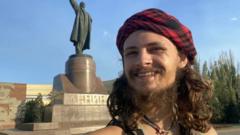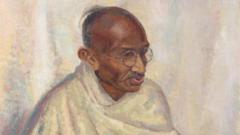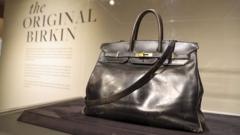BOSTON (AP) — When artist Jim Sanborn was commissioned to create a work for the CIA headquarters, he envisioned a piece that embodied the world of spies and secret codes. The outcome was 'Kryptos', a striking 10-foot-tall, S-shaped copper sculpture that, at first glance, looks like a sheet of paper ejected from a fax machine. One side displays a sequence of staggered alphabets essential for deciphering the four encrypted messages on the reverse.
Sanborn expressed, At the time, codes and encoding were an esoteric subject. I aimed to demystify it and inject a sense of fun. The ultimate goal of any artist is to engage the viewer’s attention as long as possible.
Initially, Sanborn believed the first three segments—K1, K2, and K3—would be broken swiftly, which they were. However, 35 years later, the final encryption, K4, remains unsolved, igniting obsessive curiosity among thousands of 'Kryptos' enthusiasts. One individual has contacted Sanborn weekly for over two decades with hopes of cracking K4. To manage the influx of inquiries, Sanborn began charging $50 per coded submission.
Now, at the age of 79 and after several health scares, Sanborn is auctioning the solution to K4. He hopes the new owner will become the 'keeper' of 'Kryptos', preserving its mysteries and maintaining dialogues with its dedicated following.
The auction, launched by Boston-based RR Auction, runs through November 20, with current bids reaching $201,841 for the comprehensive archive related to 'Kryptos'. Bobby Livingston, RR Auction's executive vice president, remarked that since its unveiling in 1990, 'Kryptos' has become a worldwide sensation. He praised the ongoing allure of K4, stating it has perplexed experts and novices alike.
The sold archive will contain everything necessary to unravel K4, including an added paragraph termed K5, the original coding schemes for K1, K2, and K3, and the original scrambled messages vetted by the CIA’s Department of Historical Intelligence.
Despite monumental achievements in public art, 'Kryptos' stands out. Its enigmatic text had been featured on book covers, including Dan Brown’s 'The Da Vinci Code'.
In a recent twist, Sanborn was approached by two individuals connected to the Kryptos community, who uncovered Sanborn's original encrypted texts while exploring the Smithsonian’s Archives of American Art. Although the auction's validity was questioned, Sanborn reassured the community that he alone controls the method for deciphering K4.
In discussions surrounding the auction, many fans express a desire for K4’s solution to remain undisclosed. Elonka Dunin, moderator of a prominent Kryptos enthusiast group, believes in continuing the mystery around K4’s solvability. Sanborn's aim is to ensure that the secrets of Kryptos are preserved, and he is determined to protect its legacy for future generations.
Sanborn expressed, At the time, codes and encoding were an esoteric subject. I aimed to demystify it and inject a sense of fun. The ultimate goal of any artist is to engage the viewer’s attention as long as possible.
Initially, Sanborn believed the first three segments—K1, K2, and K3—would be broken swiftly, which they were. However, 35 years later, the final encryption, K4, remains unsolved, igniting obsessive curiosity among thousands of 'Kryptos' enthusiasts. One individual has contacted Sanborn weekly for over two decades with hopes of cracking K4. To manage the influx of inquiries, Sanborn began charging $50 per coded submission.
Now, at the age of 79 and after several health scares, Sanborn is auctioning the solution to K4. He hopes the new owner will become the 'keeper' of 'Kryptos', preserving its mysteries and maintaining dialogues with its dedicated following.
The auction, launched by Boston-based RR Auction, runs through November 20, with current bids reaching $201,841 for the comprehensive archive related to 'Kryptos'. Bobby Livingston, RR Auction's executive vice president, remarked that since its unveiling in 1990, 'Kryptos' has become a worldwide sensation. He praised the ongoing allure of K4, stating it has perplexed experts and novices alike.
The sold archive will contain everything necessary to unravel K4, including an added paragraph termed K5, the original coding schemes for K1, K2, and K3, and the original scrambled messages vetted by the CIA’s Department of Historical Intelligence.
Despite monumental achievements in public art, 'Kryptos' stands out. Its enigmatic text had been featured on book covers, including Dan Brown’s 'The Da Vinci Code'.
In a recent twist, Sanborn was approached by two individuals connected to the Kryptos community, who uncovered Sanborn's original encrypted texts while exploring the Smithsonian’s Archives of American Art. Although the auction's validity was questioned, Sanborn reassured the community that he alone controls the method for deciphering K4.
In discussions surrounding the auction, many fans express a desire for K4’s solution to remain undisclosed. Elonka Dunin, moderator of a prominent Kryptos enthusiast group, believes in continuing the mystery around K4’s solvability. Sanborn's aim is to ensure that the secrets of Kryptos are preserved, and he is determined to protect its legacy for future generations.















